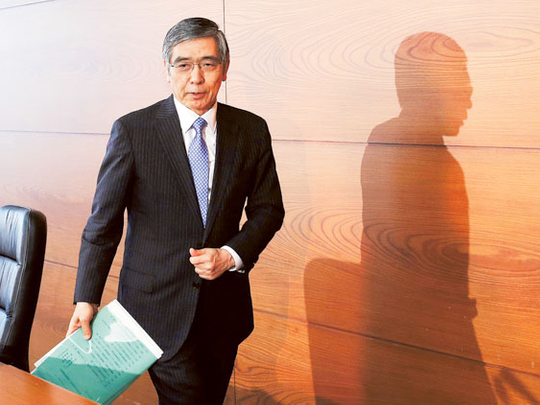
Tokyo: The Bank of Japan said an economic recovery was underway as it kept monetary policy steady on Thursday, its most optimistic view in two-and-half years reflecting the positive impact of a weakening yen and its massive monetary stimulus on activity.
The central bank made no major changes to its forecast that consumer inflation will accelerate in the coming years to near 2 per cent in the business year ending March 2016, a key target for Prime Minister Shinzo Abe’s drive to reflate the economy.
As widely expected, the BOJ voted unanimously to maintain its pledge of increasing base money, or cash and deposits at the central bank, at an annual pace of 60 trillion to 70 trillion yen ($600 billion-$700 billion).
“Japan’s economy is starting to recover moderately,” the central bank said in a statement after its two-day meeting, revising up its assessment for the seventh straight month.
The last time the BOJ used the word “recover” to describe the economy was in January 2011, two months before the March 11 earthquake and tsunami that devastated the country.
Many central bank officials are encouraged by bright signs in the economy as the yen’s fall to multi-year lows supports exports and the feel-good mood generated by Abe’s reflationary strategy bolsters consumer spending and business confidence.
The BOJ said capital expenditure had stopped weakening and was showing some signs of picking up, and also upgraded its view on factory output to say it was “increasing moderately”.
Data on Thursday supported that view, with core machinery orders, a leading indicator of capital expenditure, rising a bigger-than-expected 10.5 per cent in May.
The BOJ’s optimism suggests it will probably hold off on any additional stimulus at least until late October, when it overhauls its economic and price projections, analysts said.
“There’s no material change to the BOJ’s forecasts from April. Basically, the economy is recovering in line with its main scenario,” said Yasuo Yamamoto, senior economist at Mizuho Research Institute in Tokyo.
Financial markets have recently sold off on concerns that the US Federal Reserve may begin to scale back its $85 billion a month bond-buying programme as soon as September.
That timetable was thrown into question after Fed Chairman Ben Bernanke said on Wednesday that highly accommodative policy would be needed for the foreseeable future.
The market volatility appears to have had little impact so far on Japan’s economy, which emerged from a recession late last year to grow an annualised 4.1 per cent in the March quarter.
On Tuesday, the International Monetary Fund raised its growth forecast for Japan to 2 per cent this year on the back of the BOJ’s stimulus, its strongest forecast for a G7 nation.
The BOJ board slightly cut its median forecast for core consumer inflation to 0.6 per cent for the current business year to March 2014 from a 0.7 per cent forecast in April, likely due to the impact of falling commodity prices.
It also tweaked its core consumer inflation projection for the following year to 1.3 per cent from 1.4 per cent, but kept its estimate for fiscal 2015/16 unchanged at 1.9 per cent.
The projection remains far more ambitious than private-sector forecasts around 1 per cent, a sign many analysts doubt there can be a quick exit from 15 years of deflation.
Yamamoto of Mizuho Research said the BOJ’s price forecasts are too optimistic given concerns that demand could drop after an expected sales tax hike in Japan next April.
“The BOJ could move again early next year as downside risks to its price target are likely to become more clear,” he said.












